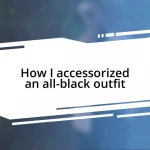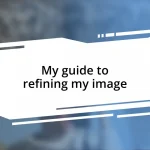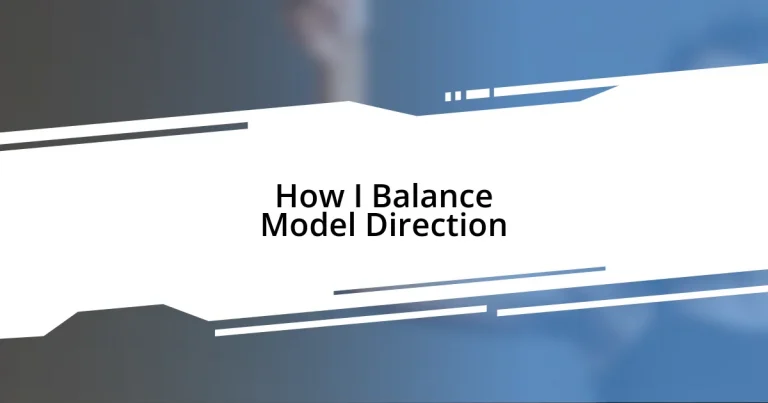Key takeaways:
- Model direction encompasses guiding principles that shape a model’s engagement and the narrative conveyed through their poses and expressions.
- Establishing clear goals enhances a model’s performance, enabling deeper emotional connections and more impactful results.
- Effective communication techniques, including using visuals and encouraging dialogue, foster collaboration and creativity in photoshoots.
- Building strong relationships with models through personal connection and positive reinforcement significantly improves their confidence and performance.
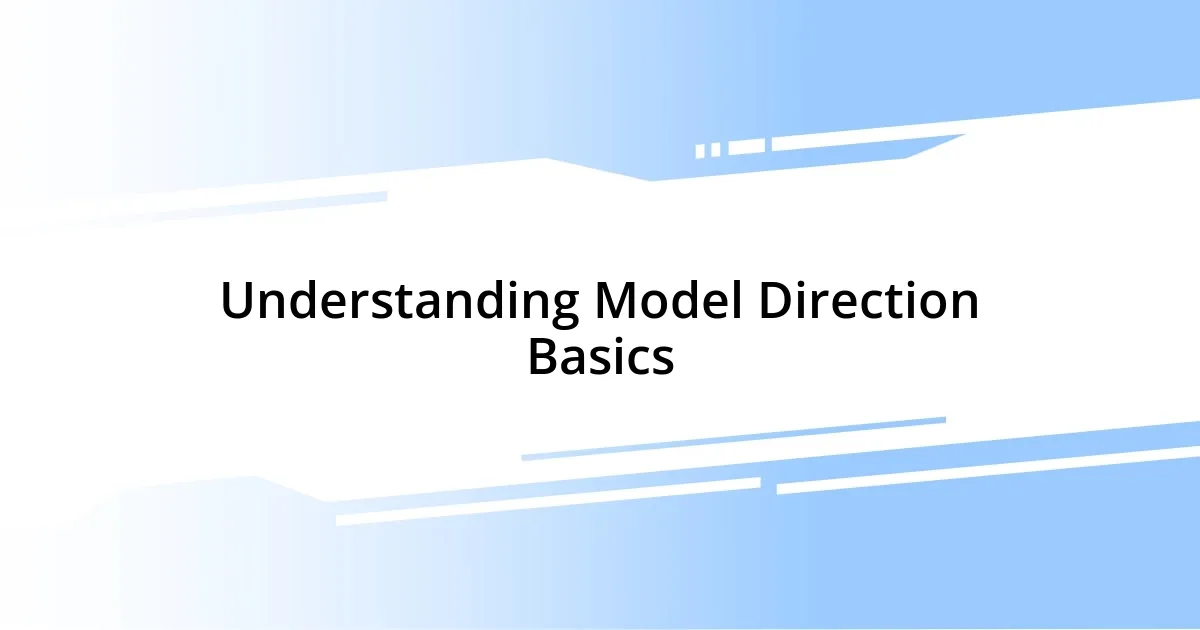
Understanding Model Direction Basics
Model direction refers to the guiding principles and choices that inform how a model communicates and engages with the audience. It’s fascinating to consider this concept in action; I remember a photo shoot where I had to direct the model’s energy. Every subtle shift of their pose dramatically altered the message conveyed, illustrating how critical it is to align direction with the intended outcome.
Digging deeper, model direction is more than just physical positioning; it’s about embodying a narrative. Have you ever noticed how a model can evoke joy with a smile or intensity with a fierce gaze? I often found that when I directed a model to connect emotionally with the camera, the entire photoshoot transformed. The essence of a great photo lies in that connection, which can only be achieved through intentional direction.
In practice, understanding model direction also means recognizing the unique personality and style of each model. During a creative collaboration, I observed that some models thrived with more freedom, while others preferred clear guidance. This individuality shaped how I approached each session, and it made me realize that a successful direction relies heavily on appreciating these nuanced differences. How do you see different directions impacting a model’s expression in your experience?
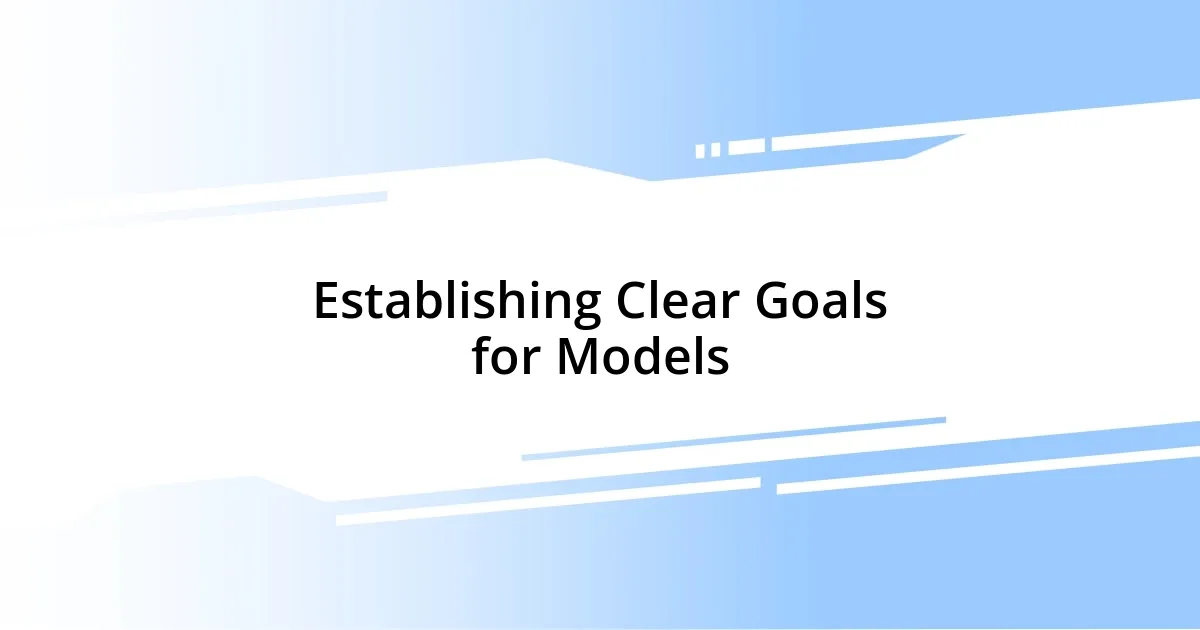
Establishing Clear Goals for Models
Establishing clear goals for models is essential for a successful photoshoot. I recall a time when I was preparing for a campaign; I set specific objectives regarding the mood and message we wanted to convey. By doing this, I found that it encouraged the model to engage more deeply with their poses and expressions, creating a coherence that resonated with the audience. Without these clear goals, the entire session felt aimless, and the results often lacked impact.
When goals are well-articulated, they empower the model to make informed choices in their performance. For instance, during a fashion shoot focused on empowerment, I communicated the importance of fierce confidence. As I guided the model through each pose, their transformation was palpable—they owned the space, radiating strength. It was rewarding to witness how effectively clear goals translated into genuine emotions, evoking a powerful response from the viewers.
Ultimately, aligning goals with a model’s personal style enhances creativity and collaboration. I remember directing a young, innovative model who thrived on spontaneity. Rather than rigidly sticking to a pre-defined vision, I adapted the goals to encourage her creativity. The images that emerged were fresh and vibrant, showcasing her unique flair while still meeting the project’s objectives. Finding that balance can lead to extraordinary results that speak volumes.
| Clear Goals | Impact on Performance |
|---|---|
| Specific Objectives | Empower the Model |
| Clear Communication | Encourage Emotional Connection |
| Flexibility | Showcase Unique Style |
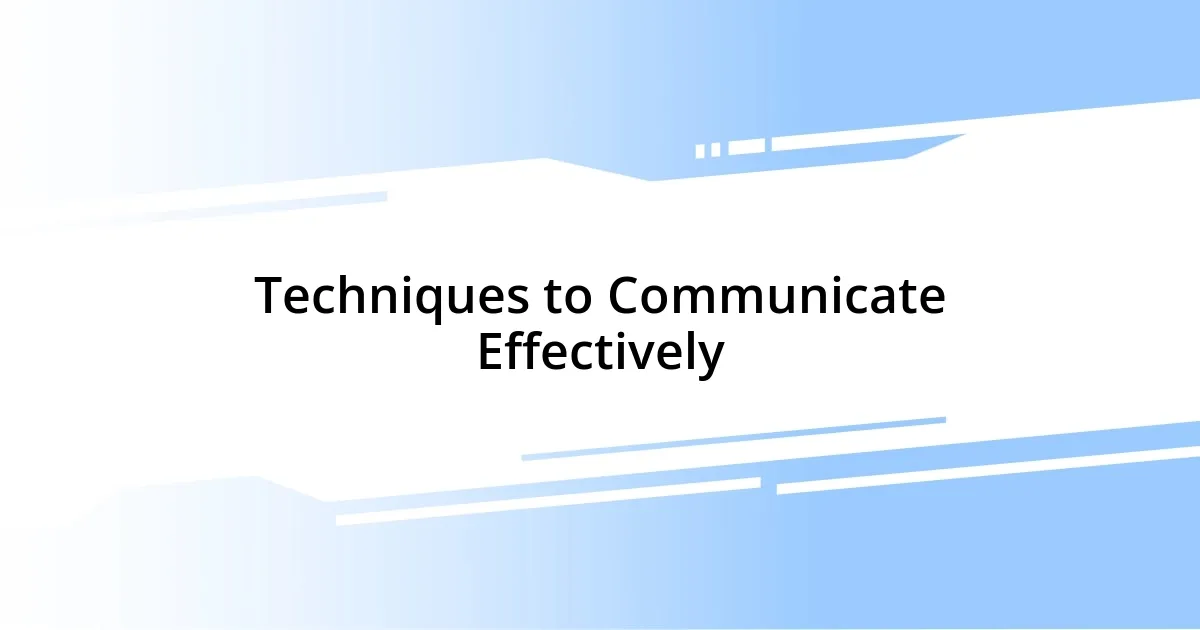
Techniques to Communicate Effectively
Effective communication in model direction is crucial for achieving the desired outcome in any photoshoot. One technique that has consistently worked for me is incorporating visual references. During a particular shoot for a beauty brand, I showed the model mood boards that featured poses and expressions we aimed to capture. This not only gave her a clearer idea of the direction but also sparked inspiration for her own interpretations, resulting in stunning images that beautifully conveyed the brand’s message.
Here are some key techniques to enhance communication with models:
- Use Visuals: Share mood boards or previous photos to illustrate your vision.
- Encourage Dialogue: Ask for the model’s input and preferences to foster collaboration.
- Be Descriptive: Clearly articulate your expectations regarding poses and expressions.
- Maintain Eye Contact: Engage with the model directly; it helps establish trust and focus.
- Provide Constructive Feedback: Offer specific and positive remarks to motivate and guide the model throughout the session.
In my experience, fostering a collaborative atmosphere can transform a photoshoot into a dynamic, creative exploration. I recall a time when I encouraged a model to share her ideas on how to convey playfulness. The results were exhilarating, and her ownership over the shoot created a playful energy that translated into eye-catching photographs. This openness not only enriched our collaboration but also underscored how communication techniques can lead to remarkable outcomes.
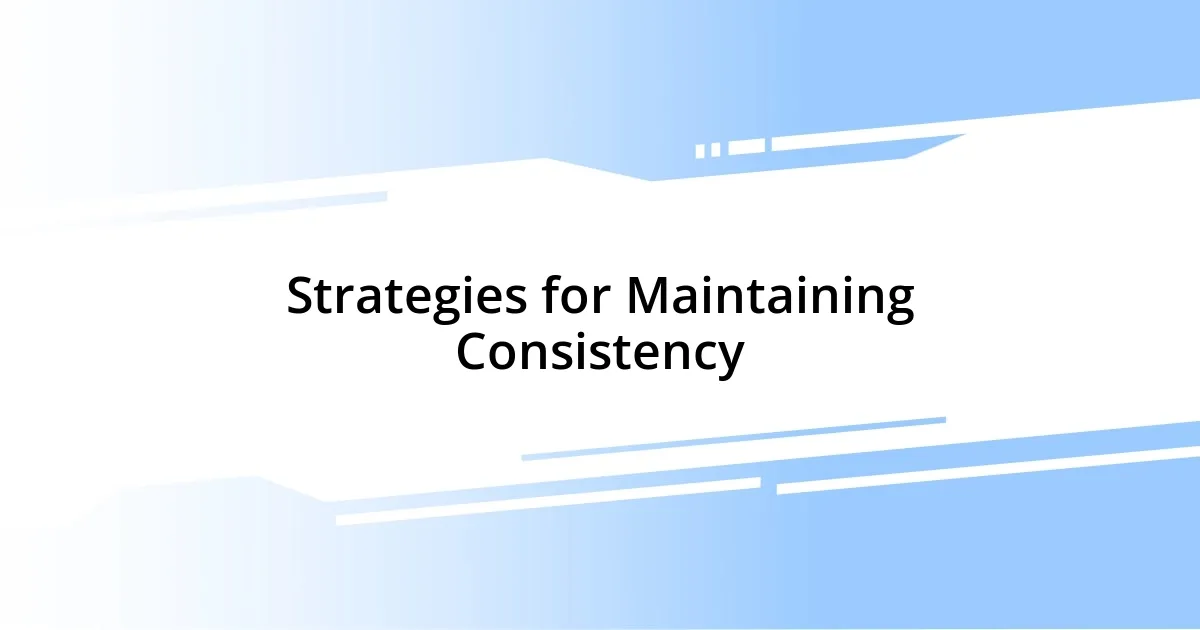
Strategies for Maintaining Consistency
Maintaining consistency in model direction can often feel like a balancing act. One strategy I’ve found invaluable is establishing a routine. For instance, during a series of back-to-back shoots, I designated specific warm-up poses to get the model into the right mindset. This consistency not only relaxed the model but also set a tone that carried throughout the sessions. Have you ever noticed how comfort can enhance performance? It’s a crucial element in creating stunning visuals.
Another effective strategy is to keep a visual diary of the best shots from each shoot. I began doing this after realizing how easy it was to lose sight of successful moments. By reflecting on those standout images, I could remind the model of what worked well previously. This practice not only reinforced our goals but also motivated both of us to strive for consistent excellence as we built upon those successful moments.
Lastly, I believe in the power of positive reinforcement. During a recent campaign, I made it a point to frequently highlight the model’s strengths with specific, encouraging comments. Rather than just saying “good job,” I would mention exactly what made a pose striking. This not only helped the model feel valued but strengthened her confidence, which led to an overall consistency in her performance. Isn’t it fascinating how a few encouraging words can make such a difference? It really motivates both the model and the creative team, creating a seamless energy that fuels the entire shoot.
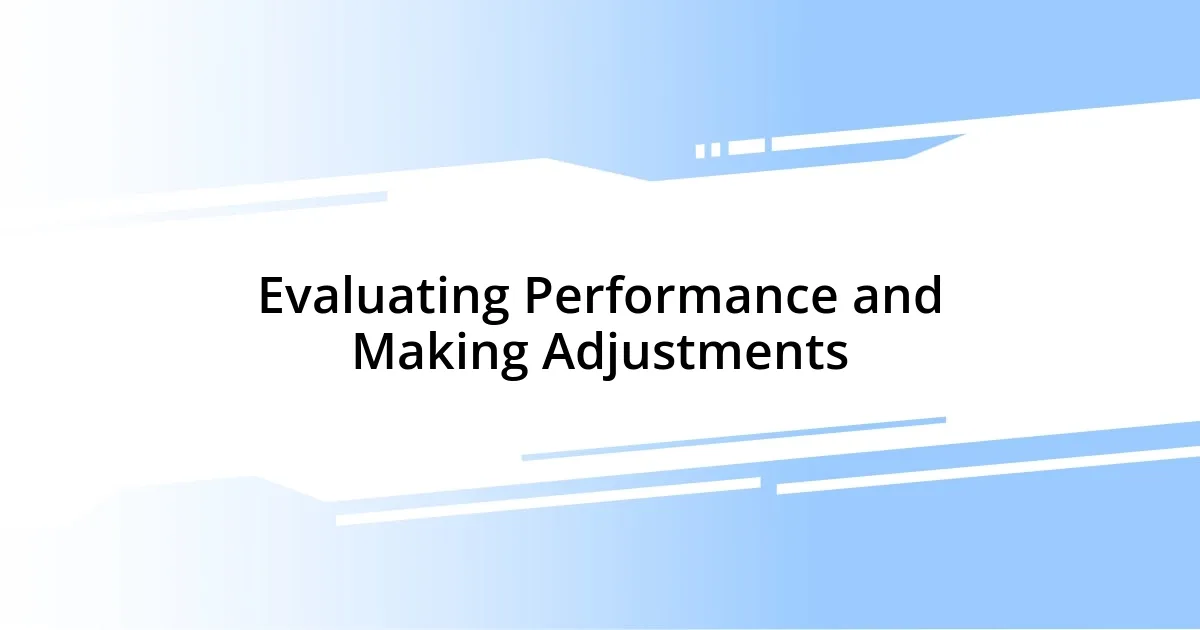
Evaluating Performance and Making Adjustments
Evaluating performance during a shoot is more than just assessing poses; it’s about reading the energy in the room. I recall a session where the atmosphere shifted when a model seemed unsure of herself. Rather than waiting until the end to assess how things went, I paused to check in with her. Asking, “How are you feeling about this pose?” opened up a dialogue that not only eased her nerves but allowed us to adjust our approach right then and there. This instant feedback loop enhanced our collaboration and led to better outcomes.
As the shoot progresses, I find it essential to make regular, small adjustments. Sometimes, I’ll notice a subtle tension in the model’s expression. When this happens, I reference a particular shot that worked well earlier, asking, “Remember how relaxed you looked here? Let’s channel that energy.” By weaving in past successes, I help the model regain her confidence and keep us aligned with our vision throughout the session.
Afterward, I take time to review the captured images, assessing not just the final result but also the journey we took together. I often jot down notes about what worked and what didn’t, remembering that evaluation is a two-way street. Have you ever contemplated how valuable it is to reflect not just on your own direction but also on the model’s contributions? This practice nurtures growth for both of us, carving a pathway for future shoots to be even more successful and enjoyable.
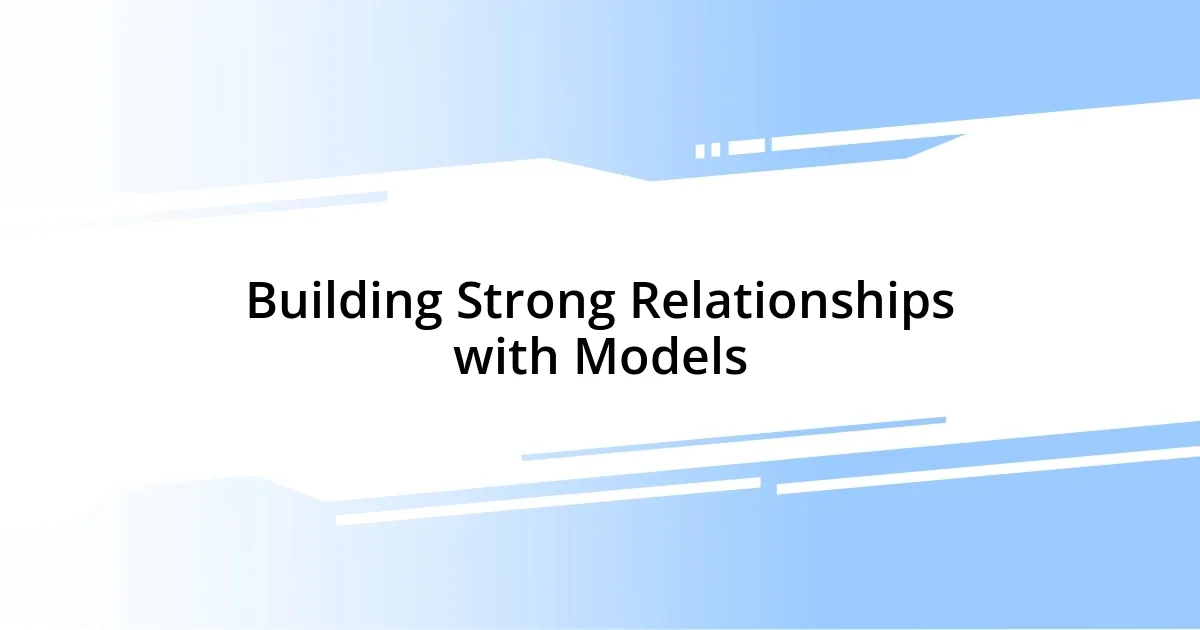
Building Strong Relationships with Models
Building strong relationships with models is foundational to a successful shoot. I can recall a moment early in my career when I overlooked the importance of communication. During a critical campaign, I assumed the model understood what I wanted without properly expressing it. That day taught me that checking in and asking simple questions like, “Do you feel good about this angle?” can do wonders for building trust. It’s remarkable how a few thoughtful words can transform the dynamic on set.
Additionally, I make it a priority to get to know each model personally. I remember chatting with one model about her interests before a shoot and discovering her love for dancing. This insight led me to incorporate fluid, dance-inspired movements into our session, making her feel more comfortable and expressive. Doesn’t it feel great when you can mesh your artistic vision with a model’s unique style? When models see that I appreciate their individuality, it fosters a deeper connection that naturally enhances their performance.
Moreover, I’m a firm believer in celebrating achievements, big and small. I once worked with a model who initially struggled with posing in front of the camera. After encouraging her with specific praises for her progress, I noticed an incredible shift in her demeanor. She began to light up with confidence! Have you experienced that moment when someone begins to thrive just from a little acknowledgment? It’s a beautiful reminder of the power of encouragement in nurturing great working relationships.

